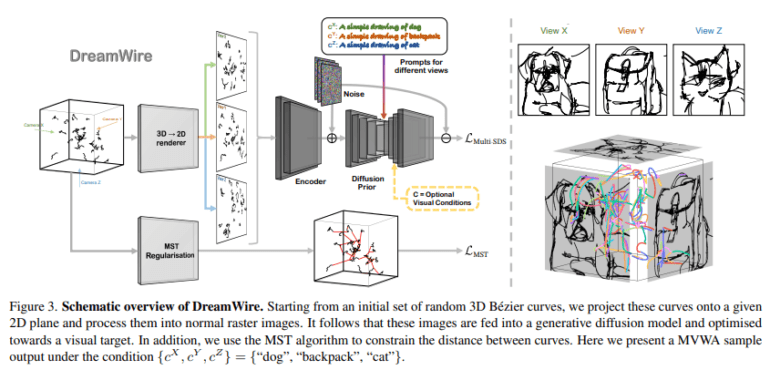TL;DR:
- DreamWire transforms 3D multi-view wire art creation using Bezier curves.
- It leverages a differentiable 2D Bezier curve renderer for optimization.
- DreamWire employs MST regularisation for stability and coherence.
- Users can input three perspectives for customized wire art.
- It bridges the gap between AI and artistic expression.
Main AI News:
In the realm where artificial intelligence and artistic expression converge, the quest for effortlessly transforming textual prompts or spontaneous sketches into intricate 3D multi-view wire art has been ongoing. Conventional methodologies such as ShadowArt and MVWA have predominantly centered around geometric optimization and visual hull reconstruction to synthesize multi-view wire art. However, the persistent challenge lies in maintaining a consistent level of fidelity in the resulting visuals, necessitating a groundbreaking and user-friendly solution to enable the creation of intricate wire sculptures.
Within the domain of multi-view wire art synthesis, existing techniques like ShadowArt delve into geometric optimization to establish a coherent shadow hull. Simultaneously, MVWA undertakes the task of reconstructing a discrete visual hull through the intersection of general cones formed by back-projecting 2D images into 3D space. While these approaches have made significant contributions, they are not without limitations. This prompted a collaborative effort between researchers from the University of Surrey and Beijing University of Posts and Telecommunications to introduce an alternative paradigm – DreamWire.
DreamWire introduces a paradigm shift in the generation of 3D multi-view wire art by conceptualizing it as a collection of cubic Bezier curves. Each wire in this innovative approach is defined by a cubic 3D Bezier curve governed by a quartet of control points. The pivotal innovation lies in the adoption of a differentiable 2D Bezier curve renderer, marking a transformative strategy for rendering 3D Bezier curves. The research team’s primary objective is to demonstrate that the projection of a 3D Bezier curve onto a plane is analogous to a 2D Bezier curve. This profound insight empowers them to optimize 3D wire art directly by utilizing a differentiable 2D Bezier curve renderer, specifically known as DiffVG.
The DreamWire workflow commences by initializing a 3D wire art structure, wherein the control points of each wire receive random initialization. Three projection planes, corresponding to orthogonal viewpoints (X, Y, Z), are established. The projection of the 3D Bezier curves onto these planes is accomplished through the utilization of the differentiable 2D Bezier curve renderer. Subsequently, the resulting 2D projections undergo refinement through a Latent Diffusion Model (LDM) coupled with Score Distillation Sampling (SDS) loss, guided by user-specified inputs.
To further enhance stability and coherence in the wire art structure, the research team introduces minimum spacing tree (MST) regularisation. This technique treats the spatial relationships between wires as a graph and employs Prim’s Algorithm to derive the minimum spanning tree. The associated cost, determined by the Euclidean distances between wire endpoints, serves as a regularization term. The final optimization objective strikes a balance between the SDS loss and MST regularisation, with the hyperparameter λ playing a crucial role in the weighting.
Experimental results underscore the versatility of DreamWire. Users have the capability to input three distinct perspectives corresponding to projections from mutually orthogonal viewpoints (X, Y, Z). This method brilliantly aligns the wire art projections with user-specified inputs, whether in the form of visual sketches or succinct text prompts. The integration of MST regularisation ensures that the wires seamlessly meld into stable and unified structures throughout the optimization iterations.
Conclusion:
DreamWire’s innovative approach to 3D multi-view wire art creation using AI technology marks a significant advancement in the market. Its ability to seamlessly align user inputs with wire art projections, whether from visual sketches or text prompts, opens up new possibilities for artistic expression and design. This technology has the potential to revolutionize the market by making complex wire sculptures more accessible and user-friendly, catering to a broader range of creative individuals and businesses seeking unique art solutions.

